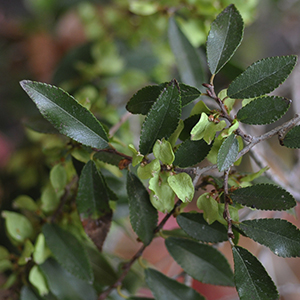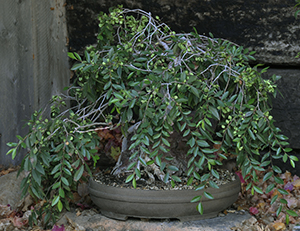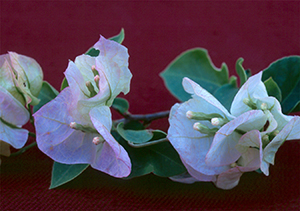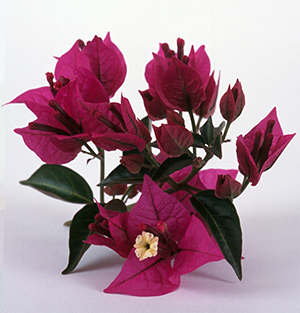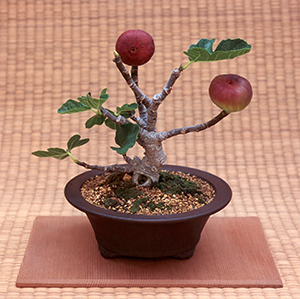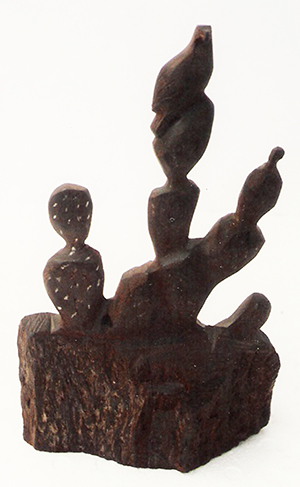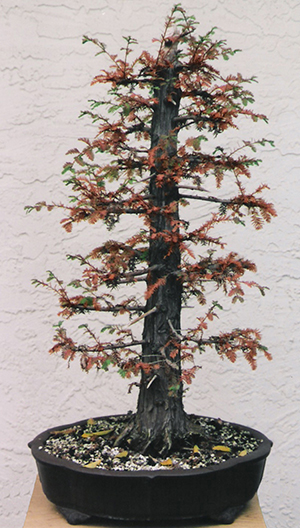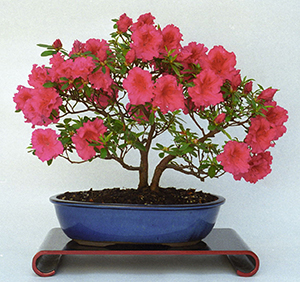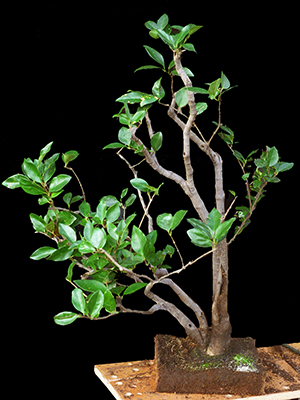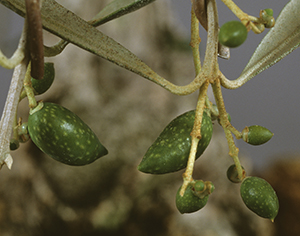Hints and Teasers
Brain Teasers
by Lew Buller
Is this tree a gymnosperm? What species is it?
The small light green leaf-like blossoms, otherwise known as flowers, are the reproductive structure of the plant.
Therefore it is an angiosperm.
The tree is a Chinese elm (Ulmus parvifolia) that flowers in the fall rather than in the spring.
What color(s) are the flowers on these bougainvillea?
The flower is the small white area in the center; the colored parts are bracts. Bracts are specialized leaves, in this case designed to attract a pollinator. Anna’s hummingbirds, plentiful in Southern California, will check the flowers, realize they are not equipped to extract the pollen, and move on to other flowers.
Where is the flower on this edible fig? What about the leaves?
The flower is inside the fig. It is fertilized by a specialized tiny wasp and will have dozens or even hundreds of seeds as anyone who has ever eaten a fresh fig will attest to.
There are three ways to reduce leaves on ficus carica:
1. When a branch develops three leaves, cut off the last two.
2. Cut the leaves in two.
3. Keep the tree root bound. Once leaf size has been reduced it can be kept down by strong pruning of new leaves.
What makes a tree a hardwood tree? Is the wood on hardwood trees harder than the wood on softwood trees?
Hardwood trees are angiosperms having coverings on the seeds, while softwood trees are gymnosperms (naked seeds) without coverings. The terms are misleading because some softwood trees are harder than some hardwood trees. Douglas fir, a softwood, is harder than some hardwoods. Black ash is a hard hardwood tree; white ash is a soft hardwood tree. Differences in density and mechanical properties account for the designations as hard or soft hardwoods.
Name two of the heaviest woods, ones that will not float in water.
Lignum vitae. Check the Internet for some interesting reading on this wood. The flower is the national flower of Jamaica.
Olneya tesota. The heartwood is extremely dense and heavy and is used by Seri Indian and Mexican wood carvers. Because it is so dense, it does not accept finishes readily but is usually completed with coats of brown shoe polish.
The Mexican Coat of Arms is an eagle on a prickly pear cactus killing a snake. I bought this piece in a not-quite-finished condition to be able to compare it to finished works. The owner of the store was upset when she discovered her clerk had sold her display piece for $15.
What is a conifer? Are there any conifers that are deciduous?
A conifer is a cone-bearing plant. Most of us in bonsai are familiar with the fact that pines are conifers and the cones are used for holiday decorations. The seeds are developed in between the scales of the cones. Although pines drop their needles over a 2-4 year period, creating an acid condition in the soil beneath them, they are not considered deciduous as they do not drop all leaves each year, growing a complete new set the next year.
There is no exact agreement about the number of conifer species, but estimates range to 600 and above. Most of the species are evergreen, but there are five genera that are deciduous, including the Metasequoia (think Dawn Redwood; it is the only living species of its genus) and Taxodium (meaning “like a yew” more on yews later). There are three species of Taxodium, including the bald cypress, one of which I own. The trees are deciduous in the north and semi-deciduous in the south. With mine, the leaves turn red-brown in late fall-early winter and new leaves come out in mid- to late winter.
For the serious student of conifers, the Royal Horticultural Society advertises a two-volume encyclopedia set with 1,500 pages and 6,000 photos covering 615 species of conifers.
Name two poisonous plants used in bonsai.
Azalea. My azalea came from the yard of a client, where it had grown in shade and with humidity blowing in from the Pacific Ocean. Azaleas are toxic to both humans and animals. Andromedotoxins are found in leaves and flowers, and in honey from the flowers. It burns the mouth causing humans to stop eating it before ingesting a fatal dose.
Privet. This one is Ligustrum japonicum and it came from a defunct nursery where it had grown unattended for many years in a box. The roots were so dense they had to be sawed apart.
Berries and leaves of the japonicum are poisonous. Berries contain syringin, which causes digestive disturbances and nervous symptoms. Ligustrum ovalifolium is a more potent poison; it contains toxic glycosides that cause headache, weakness, cold and clammy skin, abdominal pain, nausea, vomiting, and diarrhea. Both can be fatal to susceptible humans.
For good measure, I will name a third poisonous plant used in bonsai. It is the Yew, Taxus baccata. All parts are poisonous; the seeds found in the berries are extremely toxic; the poison remains toxic even after leaves and branches are cut off from the tree. No photo, I don’t own one. For a fourth example, go online and check out “Oleander bonsai.”
Tiny Olive Drupes
How are olives and peaches alike?
Both are drupes, or stone fruits, with a hard pit surrounded by soft flesh and covered with an exterior skin. The drupes shown here are from an Olive (Olea Europaea) left with me when Patrice returned to Europe for medical treatment. They followed small yellow flowers. Since olives generally don’t weep, constant wiring is required for this tree.
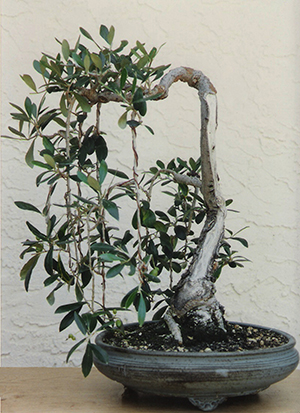
In Memoriam - Patrice
San Diego was the place the Franciscan padres chose to establish Mission San Diego de Alcala in 1769. They brought olive trees with them and by 1803 were harvesting olives and producing oil. From San Diego, olive trees were taken to other missions along the coast to San Francisco and then gradually spread to the interior valleys of central California.

